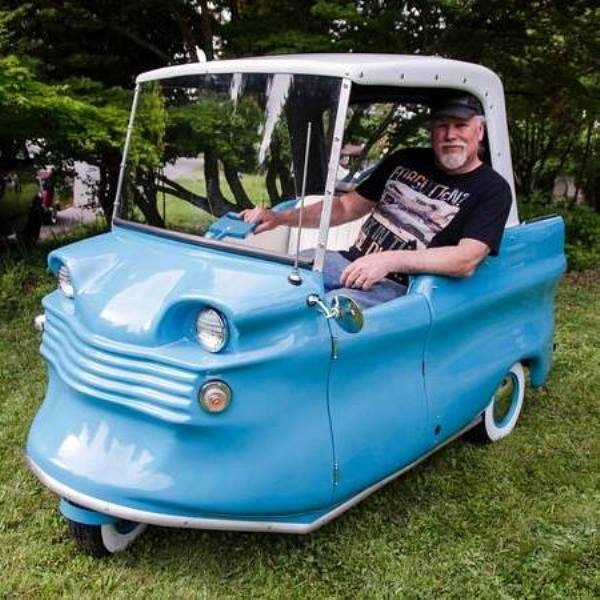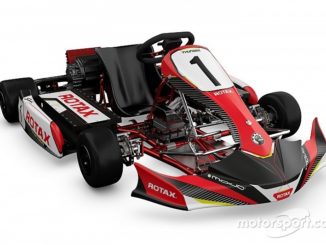di Roderick Wilde, Executive Director Historic Electric Vehicle Foundation
Dopo la seconda guerra mondiale qui negli Stati Uniti, le aziende sorti nel sud della California hanno prodotto piccole auto elettriche per andare a fare commissioni e per andare al mercato locale per l’acquisto dei generi alimentari.
Avevano nomi quali Marketeer, Marketour ed Electric Shopper.
Un protagonista importante è stato Autoette che occupava una grande quantità di mercato. Il nome Autoette è stato utilizzato per fare riferimento a questi veicoli. Ha fatto la sua strada secondo le leggi della California.
Il California Vehicle Code definisce un “autoette” come un veicolo a motore che si trova su un’isola che è più di 20.000 acri di dimensioni (circa 80 km”), all’interno di una contea con una popolazione di oltre 4 milioni di abitanti, con tre o più ruote che toccano il suolo, che pesa non più di 1.800 pounds (828 kg), è che sia lunga un massimo di 120 pollici (3048 mm) e larg un massimo di 55 pollici (1397 mm) nella sua parte più larga.
Questi piccoli veicoli elettrici sono stati i predecessori dei nostri moderni Veicoli Elettrici di Quartiere (Neighborhood Electric Vehicles – NEV). Nel 1966 il governo degli USA ha approvato la legge sulla sicurezza stradale che ha creato il National Highway Safety Bureau (NHSB) l’anno successivo. Nel 1970 la NHSB divenne la NHTSA, National Highway Traffic Safety Administration che essenzialmente ha legiferato queste micro auto elettriche permettendo la loro circolazione nelle nostre strade con alcune eccezioni quali ad esempio la legge Catalina Island in California e altre in tutto il Paese. In questo paese attualmente abbiamo ancora la NHTSA.
Nella primavera del 1996, Bombardier Inc., una società canadese più famosa per i loro Learjet, ha chiesto all’United States National Highway Traffic Safety Administration di fare un cambiamento normativo per consentire l’introduzione di una nuova classe di piccole 4 ruote, leggeri, lenti nei movimenti, questi veicoli sono stati definiti come veicoli elettrici da Quartiere (NEV). Questo veicolo è stato progettato per essere utilizzato sulle strade con un limite di velocità 25 mph (40 km/h). A causa degli sforzi della lobby di Bombardier è nata così una nuova classe di veicoli, i NEV. Il governo degli Stati Uniti aveva chiuso il cerchio da quando avevano legiferato tutti i piccoli veicoli elettrici sulle strade nel 1967.
Ecco la storia della mia piccola Shopper blu elettrica modello FG-75 del 1960, come ricercato dal nostro curatore, Larry Fisher:
 The Electric Car Company of California, Inc. ha aperto i battenti al 495 Alamitos Street di Long Beach, California, nel 1951. L’azienda è stata fondata da alcuni individui che avevano acquisito esperienza di lavoro per altri produttori di auto elettriche da shopping. Elmer Woodring ha preso il ruolo di Tesoriere del nuovo business, mentre Harry R. Casteel è stato il Vice Presidente e L. Fred Wasson presidente. Elmer Woodring e Harry R. Casteel avevano entrambi lavoravano come venditori per Autoette Sales & Service Co. durante la fine degli anni ’40.
The Electric Car Company of California, Inc. ha aperto i battenti al 495 Alamitos Street di Long Beach, California, nel 1951. L’azienda è stata fondata da alcuni individui che avevano acquisito esperienza di lavoro per altri produttori di auto elettriche da shopping. Elmer Woodring ha preso il ruolo di Tesoriere del nuovo business, mentre Harry R. Casteel è stato il Vice Presidente e L. Fred Wasson presidente. Elmer Woodring e Harry R. Casteel avevano entrambi lavoravano come venditori per Autoette Sales & Service Co. durante la fine degli anni ’40.
Chiaramente, la nuova società si proponeva di copiare la linea Autoette alla fine di produrre una linea di “vetture piacevoli”, autoveicoli industriali, e le macchine da Golf. I veicoli elettrici sono stati commercializzati sotto il nome Shopper Electric che denota la loro convenienza e destinazione d’uso. La linea comprende anche leggeri camion con pianali e persino un trasporto personale di otto passeggeri per l’uso in country club, fabbriche, aeroporti, villaggi turistici, parchi di divertimento e altro ancora.
Nel 1960 l’azienda, sotto la guida del loro nuovo presidente, Byron T. Cline, ha presentato il loro nuovo modello, la FG-75, progettato per competere con il recentemente presentato Taylor-Dunn Trident, un’auto con carrozzeria in fibra di vetro disegnato alla fine del 1950 in stile shopping. La “Nuova” Shopper elettrica è stata descritta dal produttore come “Una partenza drammatica dal progetto auto elettrica come l’avete conosciuta.” Il nuovo look offre” una bassa ed ampia silhouette delle forme distintive delle nuove grandi macchine. Silenzioso mentre è in movimento e di costruzione robusta e della stessa affidabilità che hanno goduto i Shopper elettrici per più di 25 anni”.
L’affermazione di 25 anni è un po’ esagerata, l’azienda non avrebbe mai lasciato che i fatti rovinassero un buon passo di vendite.
Il modello FG-75 del Shopper electric pesava 700 libbre (322 kg), ed è stato equipaggiato con un motore elettrico serie Wound da 1,5 CV, 24 Volt CC. La velocità come pubblicizzato era di 18 mph (29 km/h) con un’autonomia da 30 a 35 miglia (da 48 a 56 km) con una singola carica. Le opzioni popolari includevano comandi a pedale in sostituzione dei controlli standard a mano, un tettuccio in fibra di vetro rimovibile, parabrezza, e tende laterali per il tempo inclemente.
Ahimè il “Nuovo” Shopper elettrico sarebbe stato di breve durata, quando alla fine del 1962 Byron Cline ha deciso di vendere agli ex dipendenti Elmer Woodring e Wilfred Billard che stavano consolidando diverse aziende sotto l’auto elettrica Sales & Service, che chiude la produzione e la storia del Shopper elettrico.
PS: La macchina è attualmente in mostra nella hall del Ramada a Kingman, Arizona, sulla Route 66, appena fuori l’Interstate Highway 40. E’ stata esposta in tre diversi musei. E’ stata nel Petersen Automotive Museum di Los Angeles in una mostra dal titolo “Pinne, la forma senza funzione”. Più tardi è stata nel Museo dell’Automobile della California a Sacramento, la capitale della California, in una mostra dal titolo “E’ elettrizzante”. E poi è andata al nostro Route 66 Electric Vehicle Museum.
Roderick Wilde, direttore esecutivo
Historic Fondazione Electric Vehicle
In English
A bit of background on the little blue “Electric Shopper”
By Roderick Wilde, Executive Director Historic Electric Vehicle Foundation
After World War II here in the United states companies sprung up in southern California producing small electric cars to go on errands and for going to the local market for groceries.
They had names like Marketeer, Marketour, and Electric Shopper.
A major player was the Autoette which occupied a great deal of the market. The name Autoette was used to refer to these vehicles. It made it’s way into California law.
The California Vehicle Code defines an “autoette” as a motor vehicle that is located on an island that is more than 20,000 acres in size, within a county with a population of more than 4 million, with three or more wheels touching the ground, weighs no more than 1,800 pounds, is a maximum 120 inches long and is a maximum 55 inches wide at its widest part.
These small electric vehicles were the predecessors of our modern Neighborhood Electric Vehicles (NEVs). In 1966 the U.S government passed the Highway Safety Act which created the National Highway Safety Bureau (NHSB) the following year. In 1970 the NHSB became the NHTSA, National Highway Traffic Safety Administration which essentially legislated these electric micro cars off our roadways with some exceptions such as the Catalina Island law in California and others around the country. Here in this country we still have the NHTSA to this day.
In the spring of 1996, Bombardier Inc., a Canadian company most famous for their Learjets, asked the United States National Highway Traffic Safety Administration to make a regulatory change to allow the introduction of a new class of 4-wheeled small, lightweight, slow moving, vehicles they termed a Neighborhood Electric Vehicle (NEV). This vehicle was intended for use on roads with a 25 mph speed limit. Because of Bombardier’s lobbying efforts a new class of vehicle was born, the NEV. The US government had gone full circle from when they legislated all the small electric vehicles off the roadways in 1967.
Here is the history of my little blue circa 1960 Electric Shopper Model FG-75 as researched by our Curator, Larry Fisher:
The Electric Car Company of California, Inc. opened at 495 Alamitos Street in Long Beach, California in 1951. The company was started by several individuals who had gained experience working for other electric shopping car manufactures. Elmer Woodring took the role of Treasurer of the new business while Harry R. Casteel served as Vice President and L. Fred Wasson as President. Elmer Woodring and Harry R. Casteel had both worked as salesmen for Autoette Sales & Service Co. during the late 40s.
Clearly, the new firm set out to copy the Autoette line eventually producing a line of “pleasure cars,” industrial cars, and the Electric Golfer.The pleasure cars were marketed under the name Electric Shopper denoting their convenience and intended use. The line also included light trucks flatbed carriers and even an eight passenger personnel carrier for use at country clubs, factories, airports, resorts, amusement parks and more.
In 1960 the company, under the leadership of their new President, Byron T. Cline, unveiled their newest model, the FG-75, designed to compete with the recently unveiled Taylor-Dunn Trident, a fiberglass, late 1950’s styled shopping car. The “New” Electric Shopper was described by the maker as “A dramatic departure from the Electric Car design as you have known it.” The new look offered “a low, sweeping silhouette of the distinctive new big cars. Silent while in motion, yet strong in construction, the same Electric Shopper dependability you have enjoyed for more than 25 years.”
The claim of 25 years being a bit of an exaggeration, the company never let the facts ruin a good sales pitch.
The Model FG-75 Electric Shopper weighed in at a hefty 700 lbs., and was driven with a 1.5 HP, 24 Volt DC Series Wound Electric Motor. Speed as advertised was 18 mph with a range of 30 to 35 miles on a single charge. Popular options included foot controls in lieu of the standard hand controls, a removable fiberglass top, windshield, and side curtains for inclement weather.
Alas the “New” Electric Shopper would be short lived when in late 1962 Byron Cline decided to sell to former employees Elmer Woodring and Wilfred Billard who were consolidating several businesses under the Electric Car Sales & Service name thus ending the run of the Electric Shopper.
PS: The car is currently on display in the lobby of the Ramada in Kingman, Arizona on Route 66 just off Interstate Highway 40. It has been on display in three different museums. It was in The Petersen Automotive Museum in Los Angeles in a show titled “Fins, Form without Function. Later it was in The California Automobile Museum in Sacramento, the Capitol of California in a show titled “It’s Electrifying”. It then went to our Route 66 Electric Vehicle Museum for a while.
Roderick Wilde, Executive Director
Historic Electric Vehicle Foundation
no images were found



Commenta per primo